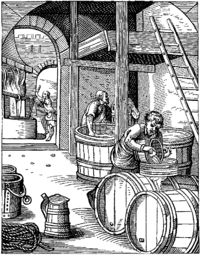
Photo from wikipedia
In this work, the effect of extrusion and fermentation on the physicochemical and digestive properties of barley powder was studied. The results showed that the contents of phenolics, β-glucan, protein,… Click to show full abstract
In this work, the effect of extrusion and fermentation on the physicochemical and digestive properties of barley powder was studied. The results showed that the contents of phenolics, β-glucan, protein, and lipid decreased after extrusion. The contents of nutrients (except lipid) increased after fermentation. Both extrusion and fermentation of barley can lead to the darkening of the color and effectively optimize the palatability by reducing the viscosity. In vitro digestion of starch showed that the content of as rapidly digestible starch increased after extrusion and fermentation. The contents of ferulic acid, 2-hydroxybenzoic acid, and caffeic acid decreased after extrusion, while the contents of chlorogenic acid, p-coumaric acid, and ferulic acid increased after fermentation. Basically, the content of all the phenolic showed an increasing trend after digestion. The antioxidant activity decreased after extrusion and increased after fermentation. Therefore, the nutritional composition and properties of barley powder were changed under the two processing methods.
Journal Title: Frontiers in Nutrition
Year Published: 2021
Link to full text (if available)
Share on Social Media: Sign Up to like & get
recommendations!